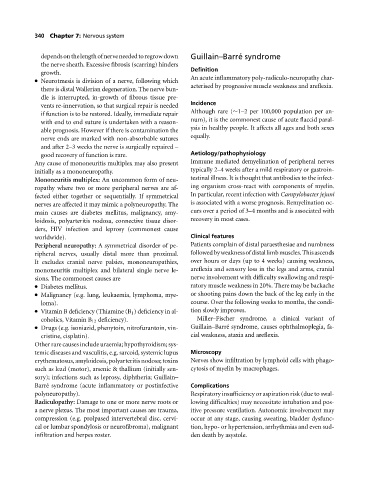Page 344 - Medicine and Surgery
P. 344
P1: FAW
BLUK007-07 BLUK007-Kendall May 25, 2005 18:18 Char Count= 0
340 Chapter 7: Nervous system
dependsonthelengthofnerveneededtoregrowdown Guillain–Barr´ e syndrome
the nerve sheath. Excessive fibrosis (scarring) hinders
Definition
growth.
An acute inflammatory poly-radiculo-neuropathy char-
Neurotmesis is division of a nerve, following which
acterised by progressive muscle weakness and areflexia.
there is distal Wallerian degeneration. The nerve bun-
dleis interrupted, in-growth of fibrous tissue pre-
vents re-innervation, so that surgical repair is needed Incidence
if function is to be restored. Ideally, immediate repair Although rare (∼1–2 per 100,000 population per an-
with end to end suture is undertaken with a reason- num), it is the commonest cause of acute flaccid paral-
able prognosis. However if there is contamination the ysis in healthy people. It affects all ages and both sexes
nerve ends are marked with non-absorbable sutures equally.
and after 2–3 weeks the nerve is surgically repaired –
good recovery of function is rare. Aetiology/pathophysiology
Any cause of mononeuritis multiplex may also present Immune mediated demyelination of peripheral nerves
initially as a mononeuropathy. typically 2–4 weeks after a mild respiratory or gastroin-
Mononeuritis multiplex: An uncommon form of neu- testinal illness. It is thought that antibodies to the infect-
ropathy where two or more peripheral nerves are af- ing organism cross-react with components of myelin.
fected either together or sequentially. If symmetrical In particular, recent infection with Campylobacter jejuni
nerves are affected it may mimic a polyneuropathy. The is associated with a worse prognosis. Remyelination oc-
main causes are diabetes mellitus, malignancy, amy- curs over a period of 3–4 months and is associated with
loidosis, polyarteritis nodosa, connective tissue disor- recovery in most cases.
ders, HIV infection and leprosy (commonest cause
worldwide). Clinical features
Peripheral neuropathy: Asymmetrical disorder of pe- Patients complain of distal paraesthesiae and numbness
ripheral nerves, usually distal more than proximal. followedbyweaknessofdistallimbmuscles.Thisascends
It excludes cranial nerve palsies, mononeuropathies, over hours or days (up to 4 weeks) causing weakness,
mononeuritis multiplex and bilateral single nerve le- areflexia and sensory loss in the legs and arms, cranial
sions. The commonest causes are nerve involvement with difficulty swallowing and respi-
Diabetes mellitus.
ratory muscle weakness in 20%. There may be backache
Malignancy (e.g. lung, leukaemia, lymphoma, mye-
or shooting pains down the back of the leg early in the
loma). course. Over the following weeks to months, the condi-
Vitamin B deficiency (Thiamine (B 1 )deficiency in al-
tion slowly improves.
coholics, Vitamin B 12 deficiency). Miller–Fischer syndrome, a clinical variant of
Drugs (e.g. isoniazid, phenytoin, nitrofurantoin, vin-
Guillain–Barr´ e syndrome, causes ophthalmoplegia, fa-
cristine, cisplatin). cial weakness, ataxia and areflexia.
Other rare causes include uraemia; hypothyroidism; sys-
temic diseases and vasculitis, e.g. sarcoid, systemic lupus Microscopy
erythematosus, amyloidosis, polyarteritis nodosa; toxins Nerves show infiltration by lymphoid cells with phago-
such as lead (motor), arsenic & thallium (initially sen- cytosis of myelin by macrophages.
sory); infections such as leprosy, diphtheria; Guillain–
Barr´ e syndrome (acute inflammatory or postinfective Complications
polyneuropathy). Respiratory insufficiency or aspiration risk (due to swal-
Radiculopathy: Damage to one or more nerve roots or lowing difficulties) may necessitate intubation and pos-
anerve plexus. The most important causes are trauma, itive pressure ventilation. Autonomic involvement may
compression (e.g. prolpased intervertebral disc, cervi- occur at any stage, causing sweating, bladder dysfunc-
cal or lumbar spondylosis or neurofibroma), malignant tion, hypo- or hypertension, arrhythmias and even sud-
infiltration and herpes zoster. den death by asystole.

